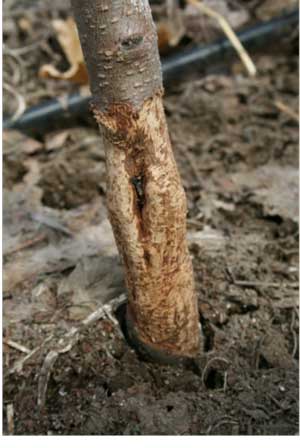
Winter rodent damage to the bark of a young tree
Mice, voles, rabbits and rodents can cause damage to young trees, saplings and shrubs during the winter months by feeding on bark, twigs, buds and foliage.
As snow accumulates around tree trunks and lower branches, it provides a great environment for little critters to tunnel around tree trunks. By tunneling under the snow, they can create a protected habitrail network for feeding, especially when deep snow on the ground is persistent.
This feeding can create small nibbling wounds in the bark and deeper layers of the tree which allow fungal and parasitic attacks come spring. In some cases, the damage can be severe enough where the trunk is girdled (eaten away entirely around the circumference) and cuts off vascular flow, killing the tree or shrub.
If the snow has a nice hard crust you will also see tree damage two or three feet off the ground – just above the snow level. Since rabbits and the like can stay on top of the snow pack while foraging, they have access to bark higher up the tree.
How to Prevent Winter Rodent Damage
Before the snow starts flying, wrap ¼ inch wire mesh around the bottom 24 inches of the tree. Be sure to sink the mesh 2 inches into the ground so the critters can’t get under it. Ensure the mesh is not too snug around the trunk and consider removing it each spring. There are also plastic tree guards that work well.
During the winter, shovel snow from around your small trees so as to eliminate the rodent habitrail feeding opportunity. This also allows predators, especially owls and hawks, to have a clear sight line to these rodents if they are going for a snack so it will naturally reduce the likelihood of rodent damage.



